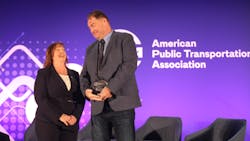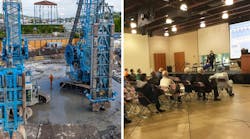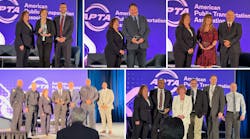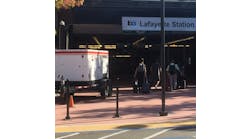BART’s three pillars of fire safety get the gold: APTA awards BART the 2023 APTA Rail Safety Gold Award
There are many threats to consider when it comes to running a multi-jurisdiction public transit system like Bay Area Rapid Transit (BART). Fire is a major concern in the often-times hot and busy tunnels housing tracks that carry trains 16 to 19 hours per day. It is important to consider all forms of preventative methods to combat and handle a fire in any situation at BART.
BART is no stranger to pulling out all the stops to maintain the safety of its riders, staff and employees. That is how BART’s Fire Life Safety Program came to be.
Tom Maloney, BART’s director of fire life safety, said BART realized its need for this program while the department was making some changes to one of its stations. The local fire department wasn’t exactly thrilled with the lack of communication that had transpired while the changes were being made.
“We had run into some heated discussion. They felt that there should have been communication in this process and to be honest, they were right. We should have been talking with the local fire departments,” Maloney said.
Maloney realized the importance of communication and collaboration in terms of new changes to a station and what the best practices would be in the event of a fire or emergency.
And so ensued the three pillars of the Fire Life Safety Program.
BART’s three pillars
The first pillar, Maloney explained, encourages familiarization through exercises and practice.
“With an outreach towards approximately 23 different fire agencies, we rotate through many exercises and drills; everything from tabletops to actual full blown wet drills in the wee hours of the night,” Maloney said. “We have a familiarization program where we take time to go and join the local fire department’s training centers and embrace their work in terms of educating them about what it is that they experience when they come inside the BART gateway.”
Maloney says a main consideration is the different environment and circumstances firefighters will experience at BART stations and properties compared to fire safety events happening in the outside world.
“When firefighters enter a BART station, they are leaving the regular world behind. There's an inherent risk for firefighters, especially considering electrical apparatus when they come up to our property. We want to make sure that we're really working with them to lock in on that kind of information and give them a comfort zone when they come to support us,” Maloney noted.
One of the bigger fire safety training exercises that BART does is held in part to honor and remember a fatal fire that occurred in 1979. The fire itself was a result of an aluminum switch box cover about the size of a serving tray breaking off a Daly City-bound BART train rolling through the Transbay Tunnel. The switch box cover had hit against the train car and rebounded into a 1,000-volt third rail and insulators. The incident brought on the worst fire the tunnel and BART had seen at the time.
Many lessons were learned from that day and were implemented into the procedures BART conducts as a part of their Fire Life Safety Program.
The safety exercise, called the Transbay Tube exercise, is held in the first couple weeks of January in the tunnel itself. BART conducts drills and practices with the Oakland and San Francisco fire departments, along with five other agencies in the area. Maloney takes part in these drills.
“I will tell you drills and exercises are so much fun to do and I really enjoy them but planning them can be a giant headache,” Maloney remarked.
Maloney’s next point was raised in the second pillar of the BART Fire Life Safety Program: Inspection of BART’s properties and stations in the form of a program based on California’s fire and safety protocols.
“We track these standards on our properties to completion using all the Safety Management Systems (SMS) protocols and hold them as our standard here in the business," Maloney said.
Maloney goes on to note the inspection program has become a full annual rotation that started out in the BART stations and expanded out to all BART properties.
The third pillar in BART’s Fire Life Safety Program is to plan standards for future structures and projects with full consideration to fire life safety protocols.
“Our end objective here is to satisfy not only our partners in fire (firefighters), but also to give our patrons and our public a safer system to ride on with all of this intact,” Maloney said.
To ensure BART remains a safe space for riders now and in the future, the BART Santa Clara Valley Transportation Authority (VTA) partnership committee was formed to safety screen the VTA BART Silicon Valley Phase II tube extension project. The BART extension through San Jose into Santa Clara is being led by VTA in partnership with BART.
Maloney serves as chair on this committee, which is currently reviewing the extension project.
“My role has been to initiate and chair the Fire Life Safety and Security Committee for the project. This brings together key stakeholders, including the fire marshals from both cities as [authorities having jurisdiction] oversight, to analyze and secure the fire code and operational components of the project design,” Maloney noted.
This collaborative approach between local fire departments and the agency was a crucial element that earned BART’s Fire Life Safety Program a Rail Safety Gold Award from the American Public Transportation Association (APTA) at the association’s Rail Conference this past June.
Communication and documentation
Communication and data keeping is essential when handling the many spread out properties of BART. To support outreach and maintenance in BART’s jurisdictions, many SMS implementations were adopted, including fire and incident maps to track and acknowledge problem hot spots on BART properties.
The data collected from these “heat maps” is shared with local fire departments and reinforcements.
“We can use that distilled information and data to work with fire partners to zone in on where we know these situations are happening now and then concentrate on follow up efforts to try to prevent and mitigate that situation,” Maloney said.
From data collected from these maps, Maloney said most incidents the Fire Life Safety program helps fire fighters encounter aren’t even fire related.
"There's not a day that goes by where we do not have fire response somewhere on the map,” Maloney said. “It's not always fire; the medical responses, the engagements with trespassers and even something as simple as a stuck elevator. It's about being robust in terms of serving our customer base as well.”
Program provides sturdy foundation
James Allison, BART’s media relations manager, said the recognition from APTA is a sign that shows BART’s ability to change with the times.
“I think it is a reflection of say, the past five years that we're not afraid to shake up the organization chart and reconfigure the way we're doing things,” Allison said. “We've done it in different ways, through different departments and the creation of a fire life safety department that didn't exist before is a reflection of that.”
While BART had always had emergency and fire safety systems, it had never really dedicated a department to such things.
"We've had robust plans, but Fire Life Safety Program and department really takes those plans and builds upon them and pours a stronger foundation for those plans to flourish should we have to engage them,” Maloney said. “It is important to really fill a void in terms of us having a lesser embrace, on the partnership that we must have with fire agencies.”
When asked what part of the job is most rewarding for Maloney as BART’s director of fire life safety, his response was simple: “I’m the luckiest guy at BART for having the good fortune of having this position and being able to work with so many positive passionate people I love working with these people and firefighters. They run in when we run out and they're always looking for solutions, no matter how many challenges the transit world provides for them, they will find a way to fix it.”
For agencies wanting to implement their own fire safety program, Maloney recommends communication between the agency’s surrounding law enforcement and fire departments. Opening a dialogue on how to make things easier and more accessible for fire and law enforcement can ultimately make things more efficient and safer for riders, employees and first responders alike.
“That approach right there is exactly what fire departments want to have because they're all about getting ahead, moving out and getting things done protecting property and protecting people,” Maloney said.

Eman Abu-Khaled | Associate Editor
Eman Abu-Khaled is a graduate of Kent State University with a bachelors in journalism. She works through Endeavor Business Media with Mass Transit as an associate editor. Abu-Khaled brings a fresh perspective to the visual side of journalism with an interest in video and photography work.




